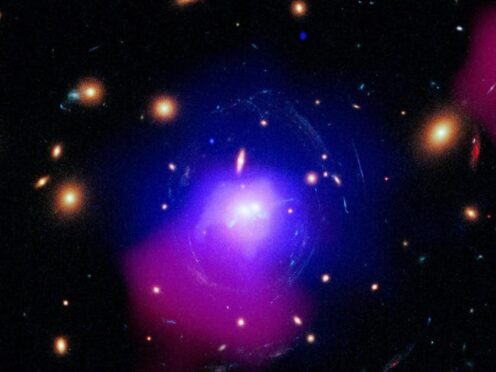
A “necklace” of young star clusters around 3.8 billion light years from Earth may have formed following an extremely powerful outburst from a “monster” black hole, scientists say.
The intergalactic bling, with a pattern of stars that resemble beads on a string, is located in a massive galaxy cluster known as SDSS J1531.
At the heart of this gigantic cluster, two of its largest galaxies are merging, surrounded by a collection of 19 large clusters of blazing infant stars.
Images of this celestial jewellery was first revealed in 2014 by Nasa’s Hubble Space Telescope.

Astronomers now believe it was formed following an extremely powerful jet – equivalent to the energy produced by a billion stars like the sun exploding all together – from a supermassive black hole around four billion years ago.
This jet pushed the hot gas surrounding SDSS J1531 away to create a gigantic cavity, much like a bubble.
Dr Timothy Davis, a reader at Cardiff University’s School of Physics and Astronomy, said: “Just like a bubble in water, that cavity rises through the hot gas.
“The beads (of star clusters) are formed as gas is compressed in front of the bubble, allowing material to cool and form star clusters that are regularly spaced.”
The team said its work, published in The Astrophysical Journal, could also shed light on how black holes act as “cosmic thermostats” to keep the gas in galaxy clusters from collapsing.
Dr Davis said: “Black hole eruptions, like the one that helped create the superclusters in SDSS J1531, are predicted to be very important in keeping the gas in galaxy clusters hot.
“Finding such clear evidence of this process ongoing allows us to understand the impact of monster black holes on their environments.”
For the study, the team analysed data from X-ray, optical radio telescopes and reconstructed the sequence of cosmic events.
Osase Omoruyi, a graduate student who led the study at the Centre for Astrophysics – a collaboration between the Smithsonian Astrophysical Observatory and Harvard College Observatory in the US, said: “We are already looking at this system as it existed four billion years ago, not long after the Earth formed.
“This ancient cavity, a fossil of the black hole, tells us about a key event that happened nearly 200 million years earlier in the cluster’s history.”
The jet produced radio and X-ray waves that were detected by Nasa’s Chandra X-ray Observatory and the Low Frequency Array (LOFAR), a radio telescope.
The team said it tracked the dense gas near the centre of SDSS J1531 revealing “wings” of bright X-ray emission at the edge of the cavity.
Dr Davis said: “This system clearly has a very active black hole, which repeatedly erupts, and is strongly affecting the gas around it.
“Here we detect the smoking gun, and see its impact all at once.”
The researchers said the team has only detected one jet so far but black holes usually fire two – in opposite directions.
They believe the radio and X-ray signals observed further afield might be the leftovers from the second jet.
The team said more observations are needed to confirm the outburst although the “evidence for this huge eruption is strong”.
Ms Omoruyi said: “We hope to learn more about the origin of the cavity we’ve already detected, and find the one expected on the other side of the black hole.”

Enjoy the convenience of having The Sunday Post delivered as a digital ePaper straight to your smartphone, tablet or computer.
Subscribe for only £5.49 a month and enjoy all the benefits of the printed paper as a digital replica.
Subscribe